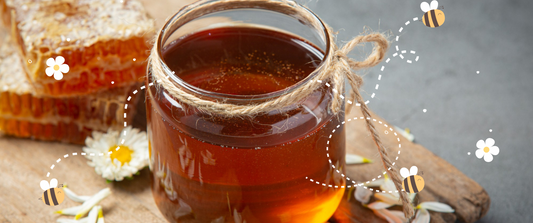Ever marveled at the diversity of honey colors you see with Humble Bee? From the translucent glow of "golden" honey to the rich amber hues, honey comes in a spectrum of colors that captivate both the eyes and the taste buds.
In this note, we unravel the mysteries behind the varying shades of honey, delving into the factors that influence its color, the science of measurement, and how the color affects not only the taste but also the nutritional profile.
Factors Influencing Honey Color:
- The journey of honey color begins with the source of nectar. Depending on the floral origin, honey can exhibit a wide range of colors, from the light and transparent spring varieties to the darker, more robust autumn harvests.
- The minerals present in the nectar source, such as sulphur, potassium, calcium, magnesium, sodium, copper, iron, and manganese, contribute to the unique palette of each honey batch.
- Storage conditions also play a role in honey color evolution. Over time, honey may crystallize, resulting in varying hues based on crystal size.
- Light honey exposed to higher temperatures gradually darkens, emphasizing the importance of proper storage in maintaining honey's original color and quality.
Measuring the Color Spectrum:
The color of honey is precisely graded using tools like the Pfund scale and Lovibond visual comparator.
- The Pfund scale employs a standard amber-colored glass wedge with a gradient, allowing for a standardized comparison of honey color.

- Lovibond visual comparator, on the other hand, utilizes a beam of light passing through the honey to determine its color by comparing it to a standard, much like the method used in evaluating the color of beer.

Does Honey Color Affect Quality?
The color of honey plays a significant role in shaping its taste and nutritional composition. Lighter honeys often boast a soft, delicate flavor, while their darker counterparts offer a more robust taste. Over time, honey may darken, but it remains safe for consumption.
Interestingly, honey color is linked to antioxidant content. Darker honey varieties tend to have higher concentrations of antioxidants compared to their lighter counterparts. This adds a layer of health benefits to the aesthetic appeal of honey.
A Spectrum of Choices for Every Palate:
In your quest for honey, whether you prefer the gentle sweetness of lighter varieties in desserts or the bold flavor of darker ones to enhance your meals, the choice is yours. Every honey variant, regardless of color, is a treasure trove of healing properties, making it a valuable addition to your daily diet. So, embrace the diversity of honey colors, savor their distinct tastes, and let this special gift from nature sweeten your day and nourish your health.






